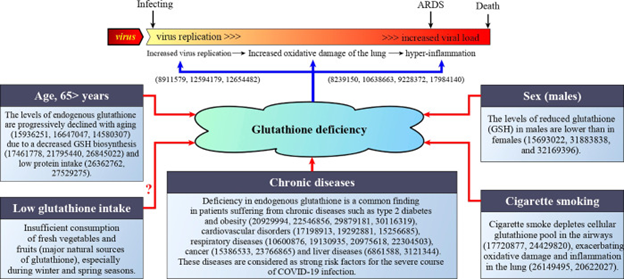Glutathione (gamma-l-glutamyl-l-cysteinyl-glycine) is a tripeptide compound formed from three amino acids: glycine, glutamic acid, and cysteine (the rate limiting AA). It maintains a significant role in antioxidant activity, redox balance, metabolic detoxification, and immune system regulation.
The following table is from Dr. Joseph Pizzorno's excellent article entitled "Glutathione!" in the Journal "Integrative Medicine - Pizzorno, Joseph. “Glutathione!.” Integrative medicine (Encinitas, Calif.) vol. 13,1 (2014): 8-12.
| Detailed overview of glutathione | |
|
Glutathione |
|
|
GSH is produced by |
|
|
Glutathione functions |
|
|
Intracellular glutathione enhanced by |
|
|
Depletion of GSH is associated with |
|
|
Clinical benefits in |
|
Glutathione is found in high concentration in the fluid lining the lung where it is secreted by epithelial cells. Low glutathione levels in cystic fibrosis and in smokers contribute to local inflammation and detrimental effects in the lung.[i]
Infection with SARS-CoV-2 causes COVID-19 (coronavirus disease 2019)
Increased oxidative stress, impaired redox homeostasis, inflammation, antioxidant and glutathione insufficiency contribute to chronic comorbidities (e.g. diabetes, cardiovascular disease, respiratory disease) and also appear to increase the severity of COVID-19.
Researchers suggest that glutathione deficiency and loss of its antioxidant and antiviral functions contribute to the more serious manifestations of COVID-19 and should be considered in a comprehensive evaluation.
In addition, insufficient intake of fresh vegetables and fruits (which account for 50% of glutathione intake) and low vitamin D may contribute to more severe COVID-19.
Researchers suggest that glutathione may regulate vitamin D synthesis and metabolism and that GSH deficiency may contribute to vitamin D deficiency and, ultimately, increased critical and fatal cases of COVID-19.
Human studies report that active vitamin D correlates positively with GSH levels while insufficient vitamin D status correlates with insufficient GSH and cysteine levels.

Polonikov 2020 This article is made available via the PMC Open Access Subset for unrestricted RESEARCH re-use and analyses in any form or by any means with acknowledgement of the original source. These permissions are granted for the duration of the World Health Organization (WHO) declaration of COVID-19 as a global pandemic.
Diet and nutrition support can affect circulating glutathione and, in turn, the vital processes that depend on it. Glutathione’s essential and conditionally amino acid components must be consumed in the diet or in supplement form for adequate glutathione to be synthesized.
Cysteine/cystine (oxidized cysteine): Pork, turkey, chicken, egg, soybean, spirulina, sesame seeds, and oats
Glutamine: Plant and animal proteins such as beef, pork, chicken, dairy products, spinach, parsley, and cabbage
Glycine: Turkey, pork, chicken, soybean, seaweed, eggs, amaranth, beef, mollusks, peanuts, pumpkin seeds, almonds, duck, goose, mung beans, sunflower seeds, lentils, lamb, bison, lobster, and fish
Certain food components and plant-based phytonutrients can enhance endogenous production and activity. These include[v] [vi]
Supplementation with individual amino acids appears to support glutathione metabolism and antioxidant status. A placebo-controlled, double-blind randomized clinical-trial (RCT) of glycine-NAC supplementation in older adults suggests the treatment:[vii]
Significantly improved
Reduced
Supplementation with glutathione itself may not be effective as the tripeptide may be destroyed by the gastric acid. However, oral liposomal forms have been found to effectively increase body stores of glutathione as demonstrated in a 2018 pilot study.[viii]
Whether coming from the inside or the outside, glutathione sufficiency should be high on the clinician’s checklist of preventive and therapeutic compounds.
[i] Forman, Henry Jay et al. “Glutathione: overview of its protective roles, measurement, and biosynthesis.” Molecular aspects of medicine vol. 30,1-2 (2009): 1-12. doi:10.1016/j.mam.2008.08.006
[ii] Polonikov, Alexey. “Endogenous Deficiency of Glutathione as the Most Likely Cause of Serious Manifestations and Death in COVID-19 Patients.” ACS infectious diseases, acsinfecdis.0c00288. 28 May. 2020
[iii] Hodges, Romilly E, and Deanna M Minich. “Modulation of Metabolic Detoxification Pathways Using Foods and Food-Derived Components: A Scientific Review with Clinical Application.” Journal of nutrition and metabolism vol. 2015 (2015): 760689. doi:10.1155/2015/760689
[iv] Lenders, C M et al. “Evaluation of a novel food composition database that includes glutamine and other amino acids derived from gene sequencing data.” European journal of clinical nutrition vol. 63,12 (2009): 1433-9. doi:10.1038/ejcn.2009.110
[v] Hodges, Romilly E, and Deanna M Minich. “Modulation of Metabolic Detoxification Pathways Using Foods and Food-Derived Components: A Scientific Review with Clinical Application.” Journal of nutrition and metabolism vol. 2015 (2015): 760689. doi:10.1155/2015/760689
[vi] Minich, Deanna M, and Benjamin I Brown. “A Review of Dietary (Phyto)Nutrients for Glutathione Support.” Nutrients vol. 11,9 2073. 3 Sep. 2019, doi:10.3390/nu11092073
[vii] Symposium presentation Sekhar, Rajagopal, George E. Taffet, and Roger Fielding. "CORRECTING GLUTATHIONE DEFICIENCY IN AGING: IMPACT ON MITOCHONDRIA, STRENGTH, INFLAMMATION AND METABOLIC DEFECTS." Innovation in Aging 3.Supplement_1 (2019): S415-S416. doi: 10.1093/geroni/igz038.1550
[viii] Sinha, R et al. “Oral supplementation with liposomal glutathione elevates body stores of glutathione and markers of immune function.” European journal of clinical nutrition vol. 72,1 (2018): 105-111. doi:10.1038/ejcn.2017.132